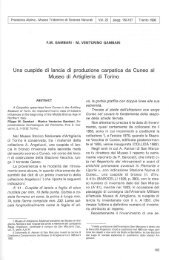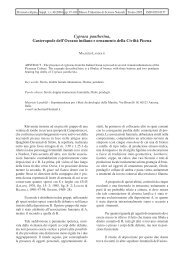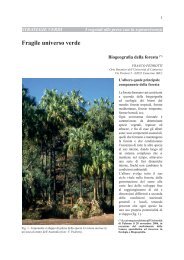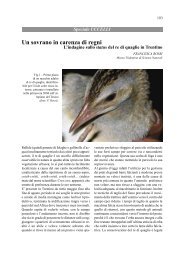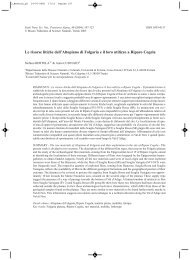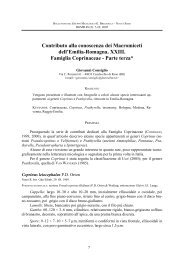Science at Museo delle Scienze - Museo Tridentino di Scienze ...
Science at Museo delle Scienze - Museo Tridentino di Scienze ...
Science at Museo delle Scienze - Museo Tridentino di Scienze ...
Create successful ePaper yourself
Turn your PDF publications into a flip-book with our unique Google optimized e-Paper software.
The main results and projects 2010-2011<br />
a special issue on springs as neglected key habit<strong>at</strong>s for bio<strong>di</strong>versity<br />
conserv<strong>at</strong>ion<br />
Section of Limnology and Phycology<br />
springs, are seriously thre<strong>at</strong>ened by<br />
several <strong>di</strong>rect and in<strong>di</strong>rect impacts, the<br />
most important being their capture to obtain<br />
drinking w<strong>at</strong>er etc. This pressure will<br />
increase even more in the future due to<br />
clim<strong>at</strong>e change. in spite of anthropogenic<br />
pressures, springs are frequently the last<br />
unpolluted, high quality freshw<strong>at</strong>er environments<br />
in densely popul<strong>at</strong>ed areas, acting<br />
as refugia for the most pollution-sensitive<br />
organisms. The potential outstan<strong>di</strong>ng<br />
importance of these habit<strong>at</strong>s for the<br />
conserv<strong>at</strong>ion of freshw<strong>at</strong>er bio<strong>di</strong>versity is<br />
slowly but increasingly being recognized.<br />
in an <strong>at</strong>tempt to contribute to the spread<br />
of knowledge on crenobiology and to promote<br />
awareness of the relevance of these<br />
habit<strong>at</strong>s for n<strong>at</strong>ure protection, the idea of<br />
grouping contributions on crenic biology<br />
and ecology in a special issue of an intern<strong>at</strong>ional<br />
journal arose. This soon became<br />
a viable project thanks to the interest with<br />
which our proposal was welcomed by the<br />
e<strong>di</strong>torial Board of the Journal of Limnology.<br />
Most of the proposed contributions<br />
for the special issue focused on bio<strong>di</strong>ver-<br />
sity and habit<strong>at</strong> conserv<strong>at</strong>ion aspects, so<br />
this volume is mainly devoted to these aspects<br />
of crenobiology. We think th<strong>at</strong> this<br />
is particularly appropri<strong>at</strong>e as the e<strong>di</strong>torial<br />
initi<strong>at</strong>ive reached its final phase in 2010,<br />
the united n<strong>at</strong>ions Intern<strong>at</strong>ional Year of<br />
Bio<strong>di</strong>versity.<br />
The core d<strong>at</strong>aset th<strong>at</strong> encouraged us<br />
to propose a special issue was obtained<br />
during a large regional project, cRenodAT<br />
(“Bio<strong>di</strong>versity assessment and integrity<br />
evalu<strong>at</strong>ion of springs of Trentino<br />
-italian Alps- and long-term ecological<br />
research”, 2004-2008).<br />
This special issue contains 13 papers.<br />
Most papers deal with the bio<strong>di</strong>versity<br />
and community ecology of a variety of autotrophic<br />
and heterotrophic, macroscopic<br />
and microscopic groups of organisms.<br />
several evalu<strong>at</strong>e the rel<strong>at</strong>ive importance<br />
of morphological (from microhabit<strong>at</strong> to<br />
large scale), physical, and chemical factors<br />
in determining community composition<br />
and structure. some <strong>di</strong>scuss the conserv<strong>at</strong>ion<br />
implic<strong>at</strong>ions of the observed p<strong>at</strong>terns.<br />
one even applies palaeolimnological<br />
techniques to a crenic habit<strong>at</strong>, showing<br />
the effects of land use and management<br />
practices around the spring-head. sp<strong>at</strong>ial<br />
and temporal changes (from seasonal to<br />
long-term) are also considered.<br />
We are gr<strong>at</strong>eful to the University and Scientific<br />
Research Service of the Autonomous<br />
Province of Trento for fun<strong>di</strong>ng the CRENODAT<br />
Project. More than half the papers in this Special<br />
Issue are based on d<strong>at</strong>a obtained during<br />
this Project. We thank the <strong>Museo</strong> <strong>Tridentino</strong> <strong>di</strong><br />
<strong>Scienze</strong> N<strong>at</strong>urali, the coor<strong>di</strong>n<strong>at</strong>ing Institution<br />
of the CRENODAT Project, for the many ways<br />
it has supported crenobiological research, in<br />
particular of its Limnology and Phycology Section.<br />
Special thanks also go to the Referees for<br />
their efforts to ensure and improve the scientific<br />
quality and consistency of the manuscripts.<br />
canton<strong>at</strong>i M., Gerecke R., Jüttner i. & cox<br />
e.J. (Guest eds.), 2011. springs: neglected<br />
Key habit<strong>at</strong>s for Bio<strong>di</strong>versity conserv<strong>at</strong>ion.<br />
Journal of Limnology, 70 (suppl. 1). 187 pp.<br />
25<br />
1R 1r<br />
2R<br />
3R<br />
4R<br />
5R<br />
6R



